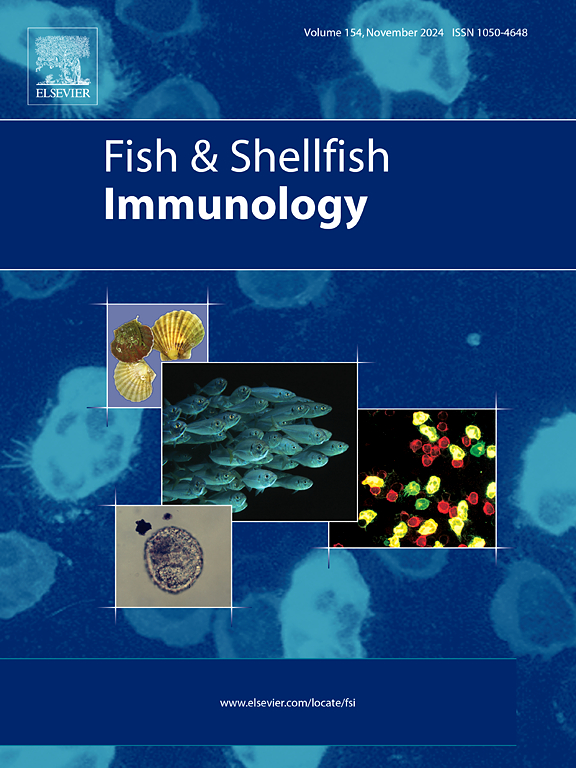Effects of chronic cold stress and thermal stress on growth performance, hepatic apoptosis, oxidative stress, immune response and gut microbiota of juvenile hybrid sturgeon (Acipenser baerii ♀ × A. schrenkii ♂)
IF 3.9
2区 农林科学
Q1 FISHERIES
引用次数: 0
Abstract
The current study was conducted to investigate the effects of chronic cold stress and thermal stress on the growth performance, hepatic oxidative status, immune response, apoptosis and gut microbiota in juvenile hybrid sturgeon. The fish (initial mean weight: 21.4 ± 0.3 g) was reared at three temperatures (14 °C, 22 °C, and 30 °C) for 16 d, which were termed as low temperature group (LT), moderate temperature group (MT), and high temperature group (HT), respectively, and the second group was regarded as control group in this study. Each group was assigned randomly to three tanks with 15 fish per replica. The results indicated that cold stress resulted in a significant reduction of growth metrics and a significant increase of feed conversion ratio in fish compared with MT group. Interestingly, cold stress increased hepatocyte apoptosis revealed by TUNEL staining, along with nuclear disappearance in H&E-stained sections and elevated serum alanine aminotransferase (ALT) and aspartate aminotransferase (AST) levels. Transcriptional levels of apoptosis-related genes and toll-like receptor signaling pathway components were significantly up-regulated in liver under cold stress. Compared with control group, in terms of thermal stress, the growth performance and feed utilization of fish were declined to some extent compared with MT group. Moreover, high temperature significantly elevated hepatic productions of malondialdehyde and hydrogen peroxide, as well as increased activities of some antioxidant enzymes in liver. In addition, low and high temperature induce changes in the composition of gut microbiota. Overall, the results suggested that cold stress decelerated growth performance, induced hepatocyte apoptosis, and enhanced innate immunity in hybrid sturgeon to cope with additional stressors. Whereas, thermal stress resulted in hepatic oxidative stress in liver and the protective responses in the antioxidant enzymes in fish were activated. These results provided insights into the different physiological adaptation strategies in responsive to cold stress and thermal stress in this cold-water fish.
慢性冷应激和热应激对杂交鲟幼鱼生长性能、肝细胞凋亡、氧化应激、免疫应答和肠道微生物群的影响
本试验旨在研究慢性冷应激和热应激对杂交鲟幼鱼生长性能、肝脏氧化状态、免疫应答、细胞凋亡和肠道菌群的影响。将初始平均体重21.4±0.3 g的鱼在14°C、22°C和30°C三种温度下饲养16 d,分别称为低温组(LT)、中温组(MT)和高温组(HT),高温组作为本研究的对照组。每组随机分配到3个水箱中,每个水箱15条鱼。结果表明,与MT组相比,冷胁迫显著降低了鱼类的生长指标,显著提高了饲料系数。有趣的是,TUNEL染色显示,冷应激增加了肝细胞凋亡,h&e染色切片细胞核消失,血清谷丙转氨酶(ALT)和天冬氨酸转氨酶(AST)水平升高。冷应激下肝脏细胞凋亡相关基因和toll样受体信号通路组分的转录水平显著上调。在热应激方面,与对照组相比,MT组鱼的生长性能和饲料利用率均有一定程度的下降。此外,高温显著提高了肝脏丙二醛和过氧化氢的产量,并增加了肝脏中一些抗氧化酶的活性。此外,低温和高温会引起肠道菌群组成的变化。综上所述,研究结果表明,冷应激降低了杂交鲟的生长性能,诱导了肝细胞凋亡,并增强了它们应对额外应激源的先天免疫。热应激引起肝脏氧化应激,激活鱼体内抗氧化酶的保护反应。这些结果为研究这种冷水鱼在冷应激和热应激下的不同生理适应策略提供了新的思路。
本文章由计算机程序翻译,如有差异,请以英文原文为准。
求助全文
约1分钟内获得全文
求助全文
来源期刊

Fish & shellfish immunology
农林科学-海洋与淡水生物学
CiteScore
7.50
自引率
19.10%
发文量
750
审稿时长
68 days
期刊介绍:
Fish and Shellfish Immunology rapidly publishes high-quality, peer-refereed contributions in the expanding fields of fish and shellfish immunology. It presents studies on the basic mechanisms of both the specific and non-specific defense systems, the cells, tissues, and humoral factors involved, their dependence on environmental and intrinsic factors, response to pathogens, response to vaccination, and applied studies on the development of specific vaccines for use in the aquaculture industry.
 求助内容:
求助内容: 应助结果提醒方式:
应助结果提醒方式:


